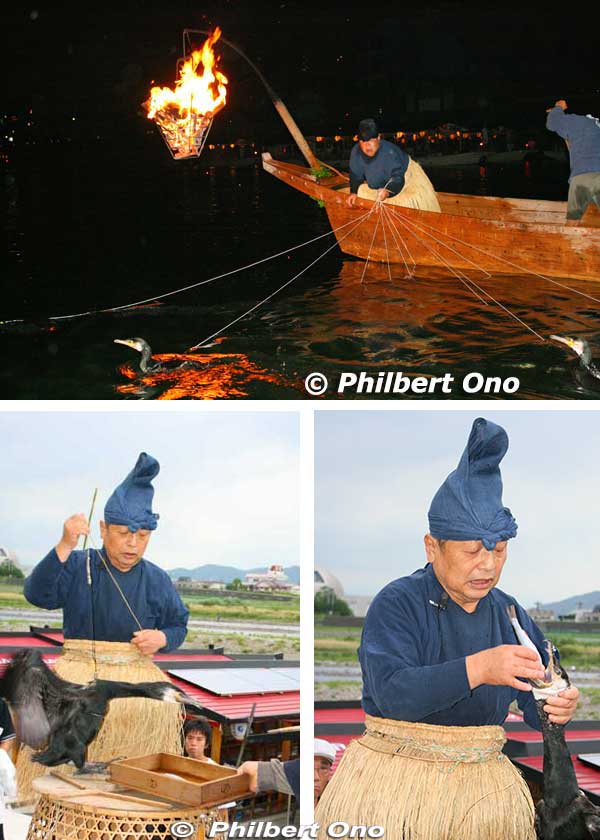
Held in the evening under torchlight on Nagara River, ukai is a traditional fishing method with a master fisherman on a wooden boat using leashed cormorants. The cormorants dive for ayu sweetfish attracted to the surface by the torchlight. The cormorants catch the fish, but a ring around their throats prevent them from swallowing the fish. The master fisherman, called “usho” (鵜匠), pulls the bird back to the boat to spit out the fish.
Paying tourists ride on small, wooden boats called “yakata-bune” (屋形船) which go upstream to be anchored on the river. Several cormorant fishing boats later pass by right in front of your boat one after another (upper photo). You can see the master fishermen with 10 to 12 leashed cormorants bobbing on the water and diving for fish. It happens quickly, so you have to watch carefully for the birds catching fish and surrendering it to the fisherman.
The cormorants are on an empty stomach, so they are motivated to hunt for fish. Amazing how the leashes don’t get tangled. The master fisherman can quickly cut the leash if it gets caught on rock underwater so the bird doesn’t drown. Unique thing to watch and great photo op.
If you go early before the boarding time, you can hear a short lecture in Japanese about ukai fishing by a master fisherman. Aided by a live cormorant (lower photos), he gives an interesting talk about ukai history, his costume, and the cormorants.
Ukai cormorant fishing on Nagara River in Gifu has a 1300-year history. It’s mentioned in ancient texts like the Nihon Shoki (Chronicles of Japan) and Kojiki (Records of Ancient Matters).
Although there’s cormorant fishing in other places in Japan, Nagara River ukai fishing is the most famous because it’s connected to the Imperial family. Nagara River’s master cormorant fishermen are actually employees of the Imperial Household Agency (Ceremonies Dept.) which is a governmental agency managing the Imperial family. They are national government employees. It’s a hereditary position and occupation.
The master cormorant fisherman’s honored title of “usho” (鵜匠) was created by feudal lord Oda Nobunaga (who once lived in Gifu Castle) in the 16th century. Only Nagara River’s master cormorant fisherman have this title. Other cormorant fishermen are simply called “u-zukai” (鵜使い), literally “servant fishermen.”
As seen in the lower photos, the usho master fisherman wears a cap (kazaori-eboshi 風折烏帽子) folded from a flat piece of hemp cloth to protect his hair from the torch fire. It also provides space for a topknot worn in the old days. He also wears a fire-protection vest (mune-ate 胸あて) and handmade straw skirt (koshimino 腰蓑) that functions as a raincoat and provides warmth. Underneath is just shorts.
The cormorants are caught in the wild in Hitachi, Ibaraki Prefecture and trained for two to three years for ukai fishing in Gifu. This master fisherman has about 20 cormorants that he cares for at his home near Nagara River. Since they live together, he and the birds are able to work well together.
The master fishermen also perform cormorant fishing for the Imperial family. The fish is offered to the Imperial family, Ise Shrine, and Meiji Shrine.
For regular tourists, Nagara River Ukai cormorant fishing is held almost every evening from May 11 to Oct. 15. Boats leave at 6:45 pm and 7:15 pm. The cormorant fishing starts at 7:45 pm. Tourists normally have the option to have dinner on the boat before the cormorant fishing boats pass by. However, to prevent the spread of Covid, eating and drinking on the boat is now prohibited. (You can still bring your own water for hydration.) They have also cut the number of tourists on the boat by half, and masks are required. Wheelchair accessible.
You can make reservations by phone or online. If you have a group of seven or more, you can charter the entire boat for the same price per person. Pricing is ¥3,500/adult on weekends and ¥3,200/adult on weekdays and ¥1,800 for elementary school children and younger. ![]()
Official site: https://www.ukai-gifucity.jp/ukai/e/
![]() To reach the boat dock, go to JR Gifu Station or Meitetsu Gifu Station and take the bus bound for Takatomi (高富) or the city loop line. Get off at Nagarabashi (長良橋). Takes about 20 min.
To reach the boat dock, go to JR Gifu Station or Meitetsu Gifu Station and take the bus bound for Takatomi (高富) or the city loop line. Get off at Nagarabashi (長良橋). Takes about 20 min.
English: https://www.gifucvb.or.jp/en/01_sightseeing/01_01_01.html